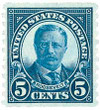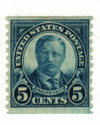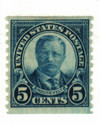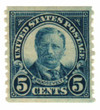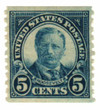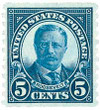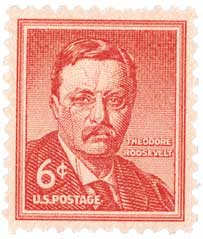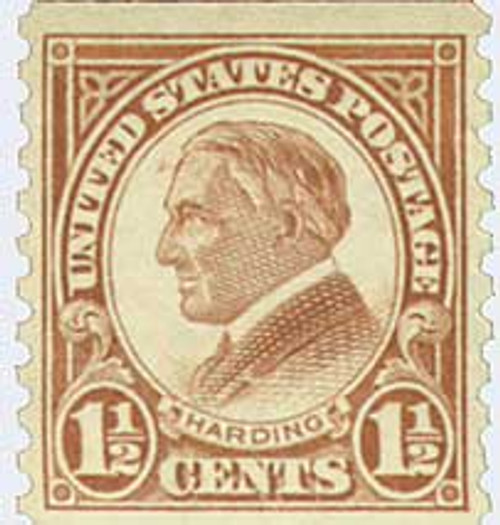
# 602 - 1924 5c Theodore Roosevelt, dark blue
U.S. #602
Series of 1923-26 5¢ Theodore Roosevelt
Issue Date: March 5, 1924
First City: Washington, D.C.
Quantity Issued: Unknown
Printed by: Bureau of Engraving and Printing
Printing Method: Rotary Press
Perforation: 10 Vertically
Color: Dark Blue
The 5¢ Series of 1923-26 stamp pictures Theodore Roosevelt. No release date for U.S. #602 was announced - similar to most of the coil stamps in the Series of 1923-26. But alert collectors were able to secure First Day Covers. The 5¢ rate paid for letters to foreign countries, where Roosevelt was still popular.
Teddy Roosevelt Suffers Family Tragedy at Age 25
Theodore Roosevelt was a young, promising politician in New York State when his wife, Alice, died of kidney failure two days after the birth of their daughter. The tragedy was even greater as his mother, Mittie, died of typhoid fever in the same house earlier in the same day. The 25-year-old Roosevelt withdrew from public life and moved to the North Dakota Territory.
Roosevelt built a ranch in the Dakota Badlands and over the next two years slowly recovered in the solitude of the wild. Once, acting as a deputy sheriff, he tracked and captured three outlaws and brought them back for trial. He stayed awake for the entire 40-hour trip, keeping himself awake by reading. After his cattle herd was wiped out in the harsh winter of 1886-87, Roosevelt returned to his home in Oyster Bay, New York. Of his time spent in the Dakota Territory, he said, "I have always said I would not have been President had it not been for my experience in North Dakota."
Teddy Roosevelt Departs For African Safari
On March 23, 1909, former president Teddy Roosevelt set sail from New York City for a joint expedition with the Smithsonian Institution.
Roosevelt's term as president ended on March 4, 1909. At 50 years old, he was America's youngest former president. Roosevelt was anxious to take a break from politics and get out of Washington, DC. At the time, the Smithsonian was building what would become the Museum of Natural History and would need exhibits. Roosevelt, ever a fan of natural history, decided to go on an African safari sponsored by the museum to collect specimens.
Roosevelt began his journey on March 23, 1909, accompanied by his son Kermit and three representatives from the Smithsonian. They steamed from New York to Italy, arriving in Mombasa on April 21. The expedition then boarded a train for a 581-mile train ride to Port Florence. Roosevelt described it as "the most interesting railway journey in the world." Roosevelt then met up with the rest of his party. It would include about 250 local guides by the time it was finished.
Over the next ten months, Roosevelt's expedition visited Kenya, the Congo, Uganda, and southern Sudan, traveling by train, horse, camel, and steamboat. During this time, they collected 23,151 natural history specimens, including about 11,397 animals. Several animals were brought back alive for the National Zoo, including a leopard, lions, cheetahs, gazelles, an eagle, a vulture, and a buteo (a broad-winged bird of prey).
In response to critics over the large number of animals captured, Roosevelt argued, "I can be condemned only if the existence of the National Museum, the American Museum of Natural History, and all similar zoological institutions are to be condemned." Roosevelt saw the trip as a scientific endeavor, as opposed to the mass killing by other hunters there to clear land for plantations.
The expedition ended on March 14, 1910. On the way home, Roosevelt stopped in Oslo, Norway, to pick up the Nobel Peace Prize he had been awarded five years earlier. Roosevelt's trip was covered extensively in the American press. Additionally, Scribner's Magazine paid him to write about the expedition. Roosevelt's stories appeared as monthly articles in the magazine and were later complied into a book, African Game Trails.
Because of the sheer number of specimens collected, it took the museum eight years to catalog them all. Several of the animals were also given to other museums. Those collected during this trip remained on display for decades, until the early 2000s. Today, only one specimen from Roosevelt's expedition remains on display at the Smithsonian, the square-lipped rhinoceros.
U.S. #602
Series of 1923-26 5¢ Theodore Roosevelt
Issue Date: March 5, 1924
First City: Washington, D.C.
Quantity Issued: Unknown
Printed by: Bureau of Engraving and Printing
Printing Method: Rotary Press
Perforation: 10 Vertically
Color: Dark Blue
The 5¢ Series of 1923-26 stamp pictures Theodore Roosevelt. No release date for U.S. #602 was announced - similar to most of the coil stamps in the Series of 1923-26. But alert collectors were able to secure First Day Covers. The 5¢ rate paid for letters to foreign countries, where Roosevelt was still popular.
Teddy Roosevelt Suffers Family Tragedy at Age 25
Theodore Roosevelt was a young, promising politician in New York State when his wife, Alice, died of kidney failure two days after the birth of their daughter. The tragedy was even greater as his mother, Mittie, died of typhoid fever in the same house earlier in the same day. The 25-year-old Roosevelt withdrew from public life and moved to the North Dakota Territory.
Roosevelt built a ranch in the Dakota Badlands and over the next two years slowly recovered in the solitude of the wild. Once, acting as a deputy sheriff, he tracked and captured three outlaws and brought them back for trial. He stayed awake for the entire 40-hour trip, keeping himself awake by reading. After his cattle herd was wiped out in the harsh winter of 1886-87, Roosevelt returned to his home in Oyster Bay, New York. Of his time spent in the Dakota Territory, he said, "I have always said I would not have been President had it not been for my experience in North Dakota."
Teddy Roosevelt Departs For African Safari
On March 23, 1909, former president Teddy Roosevelt set sail from New York City for a joint expedition with the Smithsonian Institution.
Roosevelt's term as president ended on March 4, 1909. At 50 years old, he was America's youngest former president. Roosevelt was anxious to take a break from politics and get out of Washington, DC. At the time, the Smithsonian was building what would become the Museum of Natural History and would need exhibits. Roosevelt, ever a fan of natural history, decided to go on an African safari sponsored by the museum to collect specimens.
Roosevelt began his journey on March 23, 1909, accompanied by his son Kermit and three representatives from the Smithsonian. They steamed from New York to Italy, arriving in Mombasa on April 21. The expedition then boarded a train for a 581-mile train ride to Port Florence. Roosevelt described it as "the most interesting railway journey in the world." Roosevelt then met up with the rest of his party. It would include about 250 local guides by the time it was finished.
Over the next ten months, Roosevelt's expedition visited Kenya, the Congo, Uganda, and southern Sudan, traveling by train, horse, camel, and steamboat. During this time, they collected 23,151 natural history specimens, including about 11,397 animals. Several animals were brought back alive for the National Zoo, including a leopard, lions, cheetahs, gazelles, an eagle, a vulture, and a buteo (a broad-winged bird of prey).
In response to critics over the large number of animals captured, Roosevelt argued, "I can be condemned only if the existence of the National Museum, the American Museum of Natural History, and all similar zoological institutions are to be condemned." Roosevelt saw the trip as a scientific endeavor, as opposed to the mass killing by other hunters there to clear land for plantations.
The expedition ended on March 14, 1910. On the way home, Roosevelt stopped in Oslo, Norway, to pick up the Nobel Peace Prize he had been awarded five years earlier. Roosevelt's trip was covered extensively in the American press. Additionally, Scribner's Magazine paid him to write about the expedition. Roosevelt's stories appeared as monthly articles in the magazine and were later complied into a book, African Game Trails.
Because of the sheer number of specimens collected, it took the museum eight years to catalog them all. Several of the animals were also given to other museums. Those collected during this trip remained on display for decades, until the early 2000s. Today, only one specimen from Roosevelt's expedition remains on display at the Smithsonian, the square-lipped rhinoceros.



